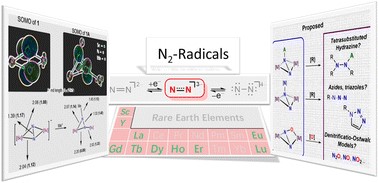The trianionic hydrazido radical (N2)3−: a promising platform for transforming N2
Josue Rolando Aguilar-Calderon, Junnian Wei*, Zhenfeng Xi*
Inorg. Chem. Front. 2023. DOI: 10.1039/D2QI02543D.

A quintessential approach to activate and functionalize the exceptionally stable diatomic nitrogen (N2) consists of its coordination to transition metal complexes. Accordingly, coordinated N2 can undergo reduction steps to deliver a variety of anionic species such as (N2)1−, (N2)2−, (N2)3− and (N2)4−. In this context, trianionic hydrazido radicals (N2)3− seem to possess atypical reactivity which can be harnessed to forge unprecedented nitrogen-element functionalities (N–E) (E = element). In spite of these promising characteristics, the reaction chemistry of metal-coordinated (N2)3− ligands remains considerably scarce in the literature. In this article, we have surveyed the limited reports related to (N2)3− species and performed preliminary DFT calculations on the known scandium–(N2)3− complex [(η5-C5Me5){nBuC(NiPr)2}Sc]2(μ2–η2:η2-N2)[{K(2.2.2)cryptand}] (1). We have emphasized the future study of the coordinated trianionic hydrazido radical (N2)3− by proposing reaction intermediates and possible reaction pathways as well as radical coupling strategies. These ideas represent an effort to stimulate alternative perspectives on the activation and transformation of N2 into N-containing compounds.




